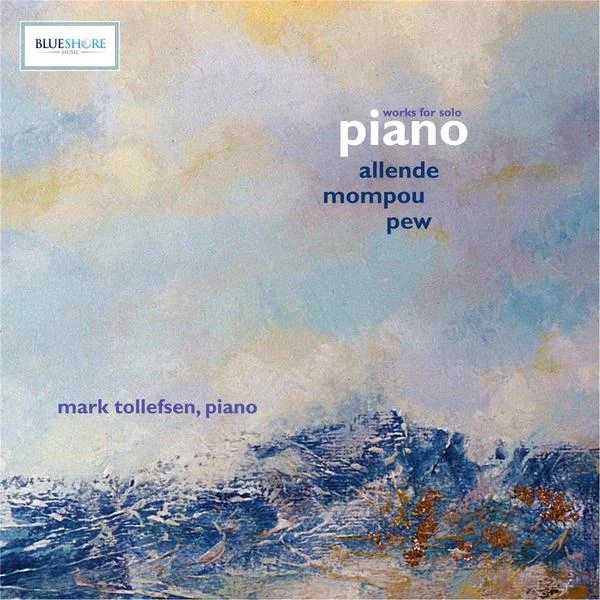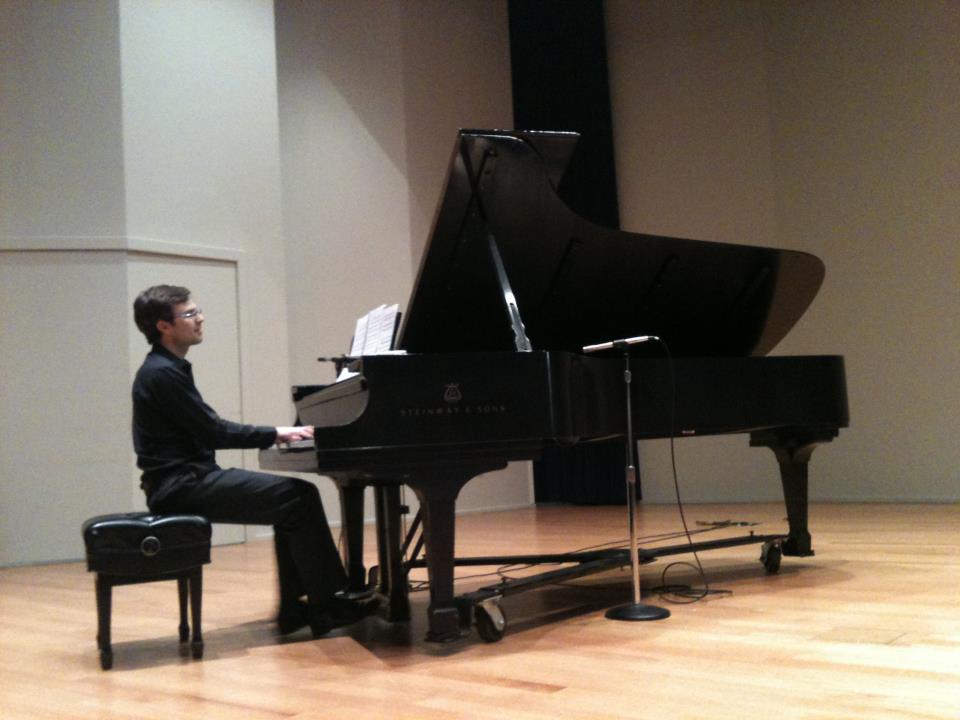Featuring "A La Orilla Azul Del Silencio" and "Bagatelles" for Solo Piano
Liner Notes by Mark Tollefsen © 2014:
Douglas Pew's A La Orilla Azul Del Silencio (On the Blue Shore of Silence) captures the spirit of Chile. His five-movement set, composed between 2012 and 2013 and commissioned by the Barlow Endowment, was inspired by lines from Chilean poet Pablo Neruda's final collection, titled El Mar Y Las Campanas (The Sea and the Bells) and Pew's own travels through Chile as, first, a missionary and later, on a grant from the Tangeman Sacred Music Center. A La Orilla Azul Del Silencio is symbolic, even personal, recalling the withdrawn world of Mompou, his "silent music," as inspired by the 16-th century Spanish mystic, Saint John of the Cross. There is loneliness and inevitability found in the repeated Cs of Llueve (It Rains), beauty and hope, but also pain, in Flores en la Luz (Flowers in the Light), and intimacy, warmth, and tranquility in Una Palpitación de Estrellas Pálidas (A Palpitation of Pale Stars). Unlike Mompou, however, Pew allows moment of unabashed exuberance within the work. The ambiguous ripples of sound that begin ¿Ahí Está el Mar? (Is the Sea There?) transform into giant, sweeping waves that gush forth and collide at the movement's climax, and ¡Fue tan bello vivír cuando vivías! (It was beautiful to live when you lived!) swells to a nearly chaotic feeling of joy. Musically, A La Orilla Azul Del Silencio is partially indebted to the techniques of the French Impressionists. There are hints of Ravel's "Le Gibet" (The Gallows) and "Osseaux tristes" (Sad Birds), and of Debussy's "La cathédrale engloutie" (The Sunken Cathedral). In addition, the final movement's construction is almost minimalist, with overlapping, ascending scales throughout. Pew's command of the harmonic language allows him to forge these influences into a unique form of expression, though, moving the music above the level of a pastiche. Even while experimenting (all five movements are unmeasured), Pew's distinctive voice is always present.
It is remarkable that Pew's Bagatelles, written in 2008, are equally representative of his style despite being completely different from the previous set. We see a composer with varied sensibilities, one who can tug at our hearts and make us laugh. The virtuosic Bagatelles are playful and contain witty programmatic elements. "Gait" depicts a "swingin' septuagenarian" while "Laps" describes a game of tag between Pew and his daughter. "Pat," inspired by the jazz guitarist Pat Metheny, instructs the piano to keep the beat with audible foot taps throughout. This movement and most of the others feature heavy doses of jazz rhythms and harmonies. The lone exception is "Devotion," a loving tribute written by Pew for his wife Janae. Its simple beauty is in stark contrast to "Locomotion," with its tempo indication of "fast and a little crazy!" Pew reintroduces excerpts from "Motion" and "Groovin'" within this driving, final movement.
Additional Notes by Scott Holden © 2014:
"A third generation of American Neo-Romanticism is well represented by Douglas Pew. Born in 1980 and educated at the Cincinnati Conservatory, he was additionally a Fulbright Scholar at the Fryderyk Chopin University of Music in Poland. Still very young, Pew has been garnering attention in the opera world with recent commissions by the Washington National Opera at the John F. Kennedy Center. His 2008 Bagatelles won first place in the 2009 SCI/ASCAP student composition competition. Drawing heavily on hard swinging jazz rhythms, these virtuoso works drive with energy and propulsion. They are not simply well crafted improvisations, they integrate sophisticated harmony within the jazz climate. Pew has a particularly strong sense of sonority, and uses the entire keyboard to great sonorous effect. The 7th bagatelle, “Locomotion”, swings with unyielding drive, as if it was being played by two of Oscar Peterson’s right hands at the same time. This would make a dazzling encore that would leave even the most devoted pianophile anxious to know who composed it. Unlike Kapustin’s piano works, the harmony is derived from jazz, but ultimately transcends the style. The simple 6th Bagatelle, “Devotion”, has a simpler meditative quality that makes it unique from it’s siblings.
Pew’s five-movement, 25-minute suite A la Orilla Azul Del Silencio was inspired by the last poems of Pablo Neruda. Sensual, other-worldly, expressive and showcasing his rich harmonic pallet, they are freely tonal and transcend any sense of measured time. This is gorgeous piano music. There are no jazz harmonies found here. “Llueve” is almost hallucinogenic as it slowly undulates around the same C for 5 minutes, while other lines sensually swim around it. Pew writes well for a pianist’s hands, once the hand crossing choreography has been worked out. The language is luminous and chromatic, with just enough hints of tonality to help juxtapose the incredible harmonic shifts. His sonic approach to the keyboard here has its ancient roots in Debussy’s pianism, demanding hushed pianissimo dynamics and a non-teleological approach to development. The writing is without bar lines or meter; the rubato effects are cleverly calculated through spatial notation. Pew has a unique voice that is sure to connect with audiences, while saying something fresh, profound and meaningful."



